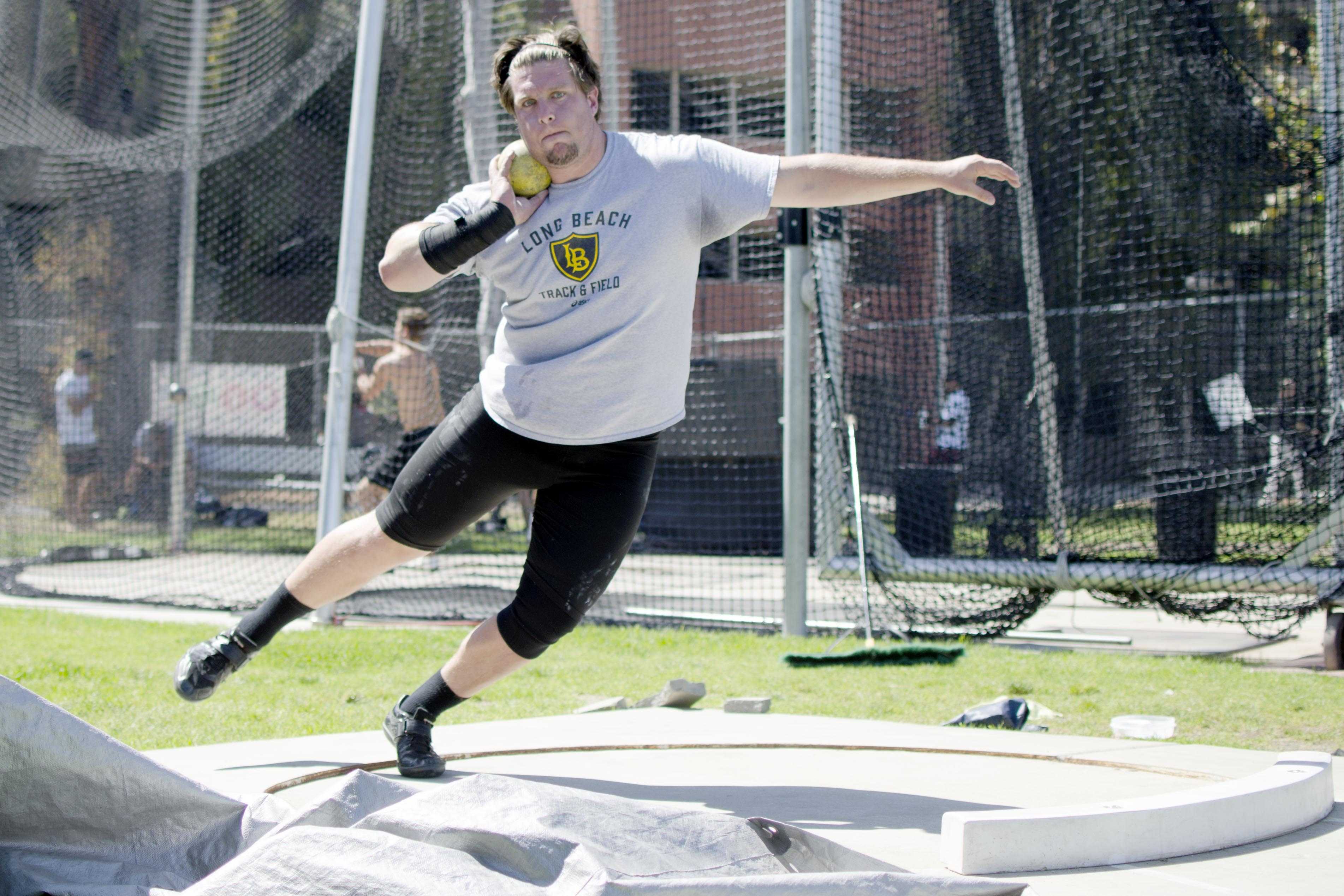He twists in, and then out. Like a dancer, the swift exacting motions of the 6’4” powerhouse command silence from his onlookers as he spins into the embodiment of self-control.
It all seems so elegant until the finishing, brutish grunt.
“It takes a lot of commitment to be out here and put the effort in,” Jake Fraser, a senior shot putter of Long Beach State’s track and field team, said. “Some days you’re just dragging along, tired from classes; you won’t want to be out here in the heat, but you do it anyways because you need to excel.”
As the four-time All-Big West Performer and 2013 Big West Champion, the throw-event specialist ranks fourth in the 49er record book for shot put and first for discus.

Track and field athlete Jacob Fraser sets himself into a ready stance before throwing the shot during practice.
His personal best is 59’6,” which was established at an invitational at University of California Irvine just two weeks into this season.
The 16-pound, iron or brass mound was inducted into the 1896 Olympic Games, according to the International Association of Athletics Federation.
Aside from the earliest recordings of ancient Greek stone tosses and British soldier cannonball competitions, modern shot put originated amongst the waving, tartan flags and rolling hills of Scotland’s 19th century Highland Games.
For Fraser, it began in his backyard.
While many reminisce on Saturdays as mindless, cartoon-filled mornings curled up with a bowl of Rice Krispies, Fraser recalls his father’s shrill holler echoing through his Lake Forest home.
Fraser’s fifth-grade introduction to the archaic sport began with his father rallying him and his siblings up for family throws at El Toro High School.
Under the influence of his older sisters, Fraser picked up the shot competitively in his teens, having yet to set it aside since.
“Through high school, it’s kind of the sport I chose to do and I was happy to do it,” Fraser said. “Once I got to college, I started appreciating it more and really falling in love with the sport.”
Though his sisters have long since graduated and retired their athletic careers, senior Victor Martin has stolen the role of Fraser’s biggest competition. Just one inch and three quarters set these two LBSU record-breakers apart.
“Jake is extremely competitive; every day in practice is a battle,” the master student, majoring in sports management at California State University, Long Beach, said. “During my first two years here I didn’t throw very well, but I knew what I was capable of. This year, it’s all coming together.”
For the past two meets, Martin has been named the Big West’s Athlete of the Week for the LBSU throwers, all while knocking Fraser down a notch as Martin slipped into the school’s third slot for all-time best marks.
“[Jake has] been the top shot putter here for the past couple of years and I have been trying to get to that point,” Martin said. “I have surpassed him with my mark this year so far, but I know that’s not the end of the battle; there’s still two more weeks.”
Fraser’s short-term scope is set on the Big West Championships that begin on May 15. As for the long-term, he entertains the idea of sticking by the shot for one more year post-collegiately to train for the U.S. Olympic Team Trials.
”In high school, I had role models. It was [all about] watching videos of other throwers and learning everything you could from them,” Fraser said. “Now, it’s videos you’ll take of yourself; it turns from being a fan into someone who could potentially have fans.”

Senior Jacob Fraser spins around with the shot before releasing it during track and field practice on Wednesday.
HOW TO
With the Big West Championships on the 7-foot ring’s horizon, Long Beach State University track and field throwers put in their career’s worth of training in the final weeks of the season for the what’s to come.
On Tuesday’s 90-degree scorcher, I crashed their practice to witness the athletes hard at work.
The following instruction is a guide on how to execute the rotary “spin” technique as opposed to the glide, written with right-handed throwers in mind.
- Grip and placement
Place the shot at the base of the fingers with a firm, yet comfortable grip. Fingers should be slightly spread apart as the thrower’s thumb holds the shot in position. With the wrist cocked outward as if the thrower were serving a pizza, place the shot against the neck. The location will differ from thrower to thrower, but should be notched under the jawline and just before aligning with the thrower’s ear. Keep the elbow high throughout the spin. If the thrower drops their elbow below the shoulder, they will be disqualified. Extend the left arm so that it is relaxed and in alignment with the shoulder to counter-balance the shot. It will be pointed perpendicular from the toe board in the starting position.
“I like to take deep breaths in my throw just to clear my mind; you never want to think too much about your throw because that’s how you throw yourself off,” Victor Martin, a fifth-year student at CSULB studying sports management, said. “Just let all the work that you’ve done to get to this point do the work for itself.”
- Stance and pivot
Stand at the back of the circle just inside of the rim, facing away from the toe board with feet spread shoulder width apart. The thrower should stand upright, looking up, with a slight bend in their knees. When the thrower is ready, begin by twisting the torso to the right. Simultaneously, their left foot will pivot inward and their right elbow should be facing the target. Shoulders should stay level. Left arm will be moving in sync with the left leg.
- The big sweep
While balancing on the ball of their left foot, the thrower will spin this foot roughly 180 degrees as they kick off of their right foot, and swing it counterclockwise outside and above the ring in what is known as a “sweep.” As the thrower’s center of gravity shifts from their left to right, the thrower will push off of their left foot after a 180 degree rotation and plant the right foot in the center of the ring partial to the front. In this snapshot, the thrower’s left arm should be reaching across their body with the right elbow pointing toward the target and hips facing the outward of the ring’s side. The torso will remain as twisted as possible for maximum torque.
“I focus on a big sweep leg out of the back, but I’m a lefty, so it’d be my left leg,” sophomore redshirt Robert Marlow, a double major in political science and philosophy at CSULB, said. ”I like to relax my right arm—it keeps your upper body back. This allows your hips to move forward, which is how you get more torque on the ball.”
- Power position and release
The thrower will then kick off with their left leg and drive it in precession, diagonally touching it down at the base of the toe board. The left foot should be flat with a firm extension of the left leg. The thrower has now reached the “power position.”
The left arm should point toward the sky, extending forward in the direction of the target. The thrower’s left leg should still be extended with its counterpart bent. With full force, the thrower will push off of their right leg and eject the shot at an approximate 45-degree angle.
“The biggest thing is getting your right hip into your throw right before you finish … because all of your power is in your legs,” Martin said, noting that this is tip is relevant to both spin and glide throwers. “If you don’t have any legs in your throw, then the ball is not going anywhere.”
- Follow through
After releasing the shot, the momentum of the rotary technique will keep the thrower in motion and shift the thrower’s center of gravity momentarily to the left as the right leg sweeps over the toe board, where it then returns inside of the ring, and exchanges the left foot’s position at the corner of the toe board. Stepping on top of the toe board or outside of the ring will result in instant disqualification.




